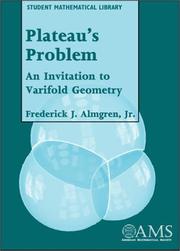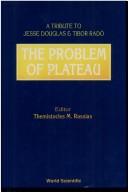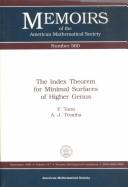| Listing 1 - 7 of 7 |
Sort by
|

ISSN: 15209121 ISBN: 0821827472 9780821827475 Year: 2001 Volume: 13 Publisher: Providence (R.I.): American mathematical society,
Abstract | Keywords | Export | Availability | Bookmark
 Loading...
Loading...Choose an application
- Reference Manager
- EndNote
- RefWorks (Direct export to RefWorks)
Minimal surfaces. --- Plateau's problem. --- Differential topology. --- Differential topology --- Minimal surfaces --- Plateau's problem --- Minimal surface problem --- Plateau problem --- Problem of Plateau --- Surfaces, Minimal --- Maxima and minima --- Geometry, Differential --- Topology

ISBN: 9810205562 9789810205560 Year: 1992 Publisher: Singapore : World scientific,
Abstract | Keywords | Export | Availability | Bookmark
 Loading...
Loading...Choose an application
- Reference Manager
- EndNote
- RefWorks (Direct export to RefWorks)
Oppervlakken [Minimale ] --- Plateau [Problème de ] --- Plateau's problem --- Probleem van Plateau --- Surfaces [Minimal ] --- Surfaces minimales --- Minimal surfaces --- Plateau, problème de --- Douglas, Jesse, --- Plateau, Joseph, --- Radó, Tibor, --- Plateau's problem. --- Minimal surfaces. --- Surfaces, Minimal --- Maxima and minima --- Minimal surface problem --- Plateau problem --- Problem of Plateau --- Radó, T. --- Radó, Tibor, --- Plateau, problème de

ISSN: 00659266 ISBN: 0821803522 Year: 1995 Publisher: Providence, RI. : American Mathematical Society,
Abstract | Keywords | Export | Availability | Bookmark
 Loading...
Loading...Choose an application
- Reference Manager
- EndNote
- RefWorks (Direct export to RefWorks)
Minimal surfaces. --- Plateau's problem. --- Index theorems. --- Surfaces minimales --- Plateau, problème de --- Plateau, problème de --- Surfaces minimales. --- Plateau, Problème de. --- Théorèmes d'indices. --- Index theorems --- Minimal surfaces --- Plateau's problem --- Minimal surface problem --- Plateau problem --- Problem of Plateau --- Surfaces, Minimal --- Maxima and minima --- Differential operators --- Global analysis (Mathematics) --- Index theory (Mathematics) --- Manifolds (Mathematics)
Book
Year: 2022 Publisher: Basel MDPI - Multidisciplinary Digital Publishing Institute
Abstract | Keywords | Export | Availability | Bookmark
 Loading...
Loading...Choose an application
- Reference Manager
- EndNote
- RefWorks (Direct export to RefWorks)
Additive manufacturing (AM), more commonly known as 3D printing, has grown trememdously in recent years. It has shown its potential uses in the medical, automotive, aerospace, and spare part sectors. Personal manufacturing, complex and optimized parts, short series manufacturing, and local on-demand manufacturing are just some of its current benefits. The development of new materials and equipment has opened up new application possibilities, and equipment is quicker and cheaper to use when utilizing the new materials launched by vendors and material developers. AM has become more critical for the industry but also for academics. Since AM offers more design freedom than any other manufacturing process, it provides designers with the challenge of designing better and more efficient products.
additive manufacturing --- modular design --- design-for-manufacturability --- design optimization --- part consolidation --- product re-design --- topology optimization --- design for additive manufacturing --- 3D printing --- aerospace --- full-life cycle manufacturing flow --- airfoil --- carbon fiber tubes --- telescoping spars --- chevrons --- porous scaffold design --- tetrahedral implicit surface modeling --- triply periodic minimal surface --- selective laser melting (SLM) --- Ti6Al4V --- structure–property relationship --- microstructure --- Hall–Petch relationship --- n/a --- structure-property relationship --- Hall-Petch relationship
Book
ISBN: 3039217313 3039217305 9783039217311 Year: 2019 Publisher: Basel, Switzerland : MDPI,
Abstract | Keywords | Export | Availability | Bookmark
 Loading...
Loading...Choose an application
- Reference Manager
- EndNote
- RefWorks (Direct export to RefWorks)
Although scientific computing is very often associated with numeric computations, the use of computer algebra methods in scientific computing has obtained considerable attention in the last two decades. Computer algebra methods are especially suitable for parametric analysis of the key properties of systems arising in scientific computing. The expression-based computational answers generally provided by these methods are very appealing as they directly relate properties to parameters and speed up testing and tuning of mathematical models through all their possible behaviors. This book contains 8 original research articles dealing with a broad range of topics, ranging from algorithms, data structures, and implementation techniques for high-performance sparse multivariate polynomial arithmetic over the integers and rational numbers over methods for certifying the isolated zeros of polynomial systems to computer algebra problems in quantum computing.
superposition --- SU(2) --- pseudo-remainder --- interval methods --- sparse polynomials --- element order --- Henneberg-type minimal surface --- timelike axis --- combinatorial decompositions --- sparse data structures --- mutually unbiased bases --- invariant surfaces --- projective special unitary group --- Minkowski 4-space --- free resolutions --- Dini-type helicoidal hypersurface --- linearity --- integrability --- Galois rings --- minimum point --- entanglement --- degree --- pseudo-division --- computational algebra --- polynomial arithmetic --- projective special linear group --- normal form --- Galois fields --- Gauss map --- implicit equation --- number of elements of the same order --- Weierstrass representation --- Lotka–Volterra system --- isolated zeros --- polynomial modules --- over-determined polynomial system --- simple Kn-group --- sum of squares --- four-dimensional space
Book
ISBN: 0691615004 0691642575 1400856450 9781400856459 0691082901 9780691082905 9780691615004 9780691615004 9780691642574 Year: 1981 Publisher: Princeton, N.J. [Tokyo] Princeton University Press University of Tokyo Press
Abstract | Keywords | Export | Availability | Bookmark
 Loading...
Loading...Choose an application
- Reference Manager
- EndNote
- RefWorks (Direct export to RefWorks)
Mathematical No/ex, 27Originally published in 1981.The Princeton Legacy Library uses the latest print-on-demand technology to again make available previously out-of-print books from the distinguished backlist of Princeton University Press. These editions preserve the original texts of these important books while presenting them in durable paperback and hardcover editions. The goal of the Princeton Legacy Library is to vastly increase access to the rich scholarly heritage found in the thousands of books published by Princeton University Press since its founding in 1905.
Riemannian manifolds. --- Minimal surfaces. --- Surfaces, Minimal --- Maxima and minima --- Manifolds, Riemannian --- Riemannian space --- Space, Riemannian --- Geometry, Differential --- Manifolds (Mathematics) --- Differential geometry. Global analysis --- Addition. --- Analytic function. --- Branch point. --- Calculation. --- Cartesian coordinate system. --- Closed geodesic. --- Codimension. --- Coefficient. --- Compactness theorem. --- Compass-and-straightedge construction. --- Continuous function. --- Corollary. --- Counterexample. --- Covering space. --- Curvature. --- Curve. --- Decomposition theorem. --- Derivative. --- Differentiable manifold. --- Differential geometry. --- Disjoint union. --- Equation. --- Essential singularity. --- Estimation. --- Euclidean space. --- Existence theorem. --- Existential quantification. --- First variation. --- Flat topology. --- Fundamental group. --- Geometric measure theory. --- Great circle. --- Homology (mathematics). --- Homotopy group. --- Homotopy. --- Hyperbolic function. --- Hypersurface. --- Integer. --- Line–line intersection. --- Manifold. --- Measure (mathematics). --- Minimal surface. --- Monograph. --- Natural number. --- Open set. --- Parameter. --- Partition of unity. --- Pointwise. --- Quantity. --- Regularity theorem. --- Riemann surface. --- Riemannian manifold. --- Scalar curvature. --- Scientific notation. --- Second fundamental form. --- Sectional curvature. --- Sequence. --- Sign (mathematics). --- Simply connected space. --- Smoothness. --- Sobolev inequality. --- Solid torus. --- Subgroup. --- Submanifold. --- Summation. --- Theorem. --- Topology. --- Two-dimensional space. --- Unit sphere. --- Upper and lower bounds. --- Varifold. --- Weak topology.
Book
Year: 2022 Publisher: Basel MDPI Books
Abstract | Keywords | Export | Availability | Bookmark
 Loading...
Loading...Choose an application
- Reference Manager
- EndNote
- RefWorks (Direct export to RefWorks)
Additive manufacturing (AM) is continuously improving and offering innovative alternatives to conventional manufacturing techniques. The advantages of AM (design freedom, reduction in material waste, low-cost prototyping, etc.) can be exploited in different sectors by replacing or complementing traditional manufacturing methods. For this to happen, the combination of design, materials and technology must be deeply analyzed for every specific application. Despite the continuous progress of AM, there is still a need for further investigation in terms of design and applications to boost AM's implementation in the manufacturing industry or even in other sectors where short and personalized series productions could be useful, such as the medical sector. This Special Issue gathers a variety of research articles (12 peer-reviewed papers) involving the design and application of AM, including innovative design approaches where AM is applied to improve conventional methods or currently used techniques, design and modeling methodologies for specific AM applications, design optimization and new methods for the quality control and calibration of simulation methods.
4D printing --- material extrusion --- shape changing behavior --- shape memory polymers --- print pattern --- infill density --- polylactic acid --- SLM --- defocusing --- IN 625 --- melt pool --- tensile testing --- density --- selective laser melting --- powder spreading defect --- machine vision --- classifier --- finite element thermal analysis --- model calibration --- thermographic image --- bead on plate test --- Bayesian optimization --- nickel-based superalloy --- tissue engineering --- scaffold --- material extrusion additive manufacturing --- 3D geometry modelling --- finite element analysis --- mechanical properties --- additive manufacturing --- closed impeller --- MPFL pumps --- balancing --- non-destructive testing --- triply periodic minimal surface --- 316 L stainless steel --- energy absorption --- deformation mechanism --- flexible pressure sensor --- microstructure --- 3D printing --- composite film --- stress shielding --- total hip replacement --- femoral component --- lattice --- 3d printing --- aseptic loosening --- bone remodelling --- internal structures --- biomimicry --- 15-5 PH stainless steel --- in-situ neutron diffraction --- low-cycle fatigue --- martensite transformation --- structural joints --- aging --- ABS --- PETG --- PLA --- aluminum --- polymer rheology --- thermal joining --- topological optimization --- hybrid technology --- investment casting --- n/a
| Listing 1 - 7 of 7 |
Sort by
|

 Search
Search Feedback
Feedback About UniCat
About UniCat  Help
Help News
News